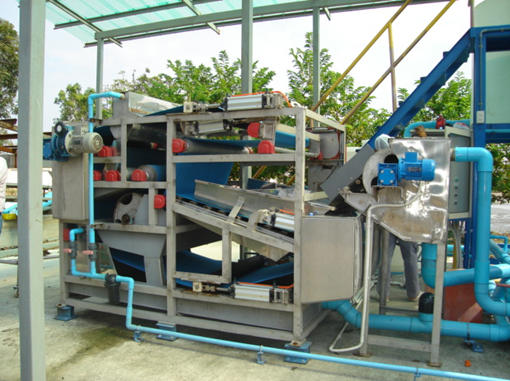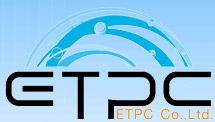Wastewater Treatment
ระบบบำบัดน้ำเสีย ระบบกำจัดไขมัน และน้ำมัน ระบบบำบัดน้ำเสียด้วยวิธีทางเคมี (Chemical Treatment System) ระบบบำบัดน้ำเสียด้วยวิธีทางชีวภาพ (Biological Treatment System)
Belt Press
A Belt Filter Press is a Biosolids/sludge dewatering device that applies mechanical pressure to a chemically conditioned slurry, which is sandwiched between two (2) tensioned belts, by passing those belts through a serpentine of decreasing diameter rolls. The machine can actually be divided into three (3) zones: gravity zone, where free draining water is drained by gravity through a porous belt; wedge zone, where the solids are prepared for pressure application; and pressure zone, where medium, then high pressure is applied to the conditioned solids.
Typically, a belt filter press receives a slurry ranging from 1-4% feed solids and produces a final product of 12-35% cake solids. Performance depends on the nature of the solids being processed
Gravity Zone
The gravity zone should be available in a standard length, extended length, and independent zone designed for normal, poor draining or dilute sludges.
High rate drainage technology developed for enhancing the performance (higher production rates at higher thickened sludge solids) of gravity belt thickeners also has its application in the gravity section of a belt press by creating more residence time in the gravity zone thereby providing for greater drainage capabilities and higher solids concentrations at discharge. Other belt presses having standard plow systems cannot achieve equal production capabilities.
An independent gravity zone has the same capability as a stand-alone gravity belt thickener and, therefore, has application on a dilute sludge where the suspended solids are less than 1.5%. Further, a Belt Filter Press may be designed as a combination thickening unit/dewatering unit. In the thickening mode, a doctor blade is engaged at the discharge roll to remove thickened solids from the gravity belt. In the dewatering mode, the doctor blade is retracted to allow the thickened sludge to enter the wedge zone.
Wedge Zone
The adjustable wedge provides a gradually applied increasing pressure as the solids approach the first dewatering drum. Pressure is applied by the upper tensioned belt by moving the wedge zones entrance roller thereby reducing or eliminating solids migration beyond the belt edges which can occur on conventional press designs.
Pressure Zone
The pressure zone should begin with a large diameter self-bailing, perforated dewatering drum designed to remove a high volume of filtrate and prevent "upset" conditions.
Because of its large diameter, large belt wrap and perforated, self-bailing design, the initial drum extracts more water from the sludge at the inlet to the pressure/shear zone than does the conventional press and because of its internal baffle design prevents the rewetting of cake on the bottom half of the roll.
The use of this larger first drum and a succession of decreasing diameter drums gradually increases the pressure profile to a maximum dewatering force. A pressure drum profile up to a maximum of 14 drums provides an extra long pressure/shear zone with more belt area in contact with the dewatering drums and thus provides more time under pressure for more thorough dewatering.
Finally, an extra long pressure/shear section provides more belt area in contact with dewatering drums and thus provides more time under pressure for more thorough dewatering.
Automation options include:
- Startup and Shutdown
- Level Control
- Flow Control
- Polymer Feed Rate
- DCS interfacing
- Alarms
- Diagnostics and Trouble Shooting





